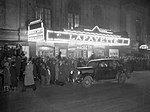Lafargue Clinic

The Lafargue Mental Health Clinic, more commonly known as the Lafargue Clinic, was a mental health clinic that operated in Harlem, Manhattan, New York, from 1946 until 1958. The clinic was named for French Marxist physician Paul Lafargue and conceived by German-American psychiatrist Fredric Wertham, who recognized the dire state of mental health services for blacks in New York. With the backing of black intellectuals Richard Wright and Ralph Ellison, as well as members of the church and community, the clinic operated out of the parish house basement of St. Philip's Episcopal Church and was among the first to provide low-cost psychiatric health services to the poor, especially for poor blacks who either could not afford treatment at New York hospitals or were victimized by racism from doctors and other hospital staff. The staff consisted entirely of volunteers, and Wertham and Hilde Mosse were the clinic's lead doctors. Though the clinic only operated for 12 years, Wertham and Mosse's experiences from Lafargue were cited in a court decision to integrate schools in Wilmington, Delaware, and later in Brown v. Board of Education, which ruled that separate black and white schools were unconstitutional. Wertham would use case studies from his time at the clinic to support his later arguments that comic books caused juvenile delinquency, as evidenced in his 1954 work Seduction of the Innocent.
Excerpt from the Wikipedia article Lafargue Clinic (License: CC BY-SA 3.0, Authors, Images).Lafargue Clinic
West 133rd Street, New York Manhattan
Geographical coordinates (GPS) Address Nearby Places Show on map
Geographical coordinates (GPS)
| Latitude | Longitude |
|---|---|
| N 40.814722222222 ° | E -73.945277777778 ° |
Address
Saint Philip's Episcopal Church
West 133rd Street 213
10030 New York, Manhattan
New York, United States
Open on Google Maps








